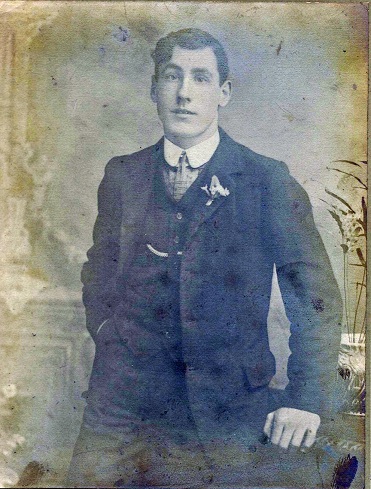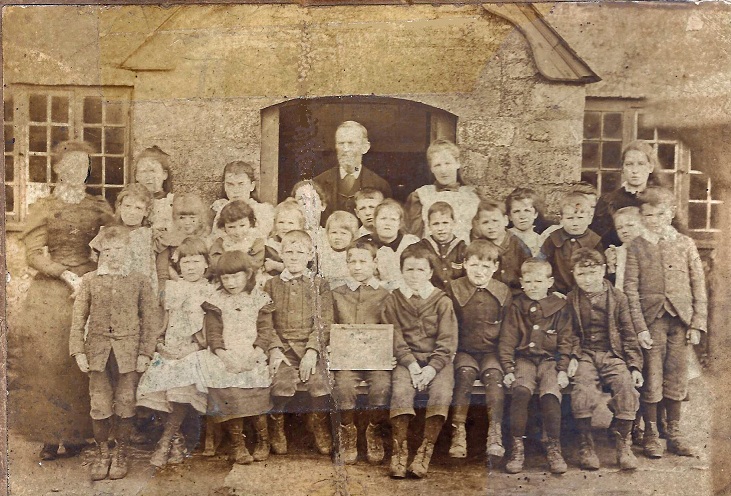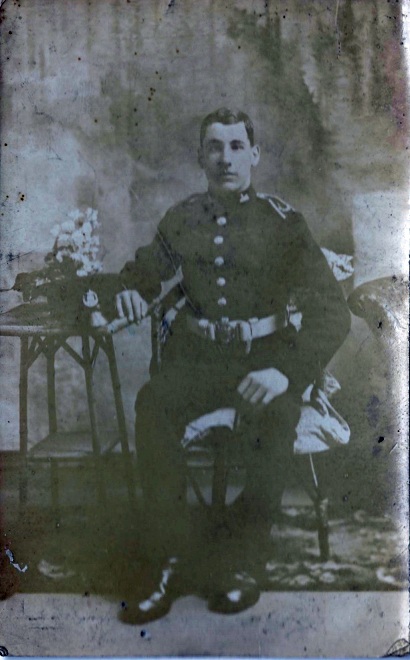 Alexander William Sanders (known as Will), his twin brother Joseph Henry (known as Harry) and his sister Sabina were born and brought up in Shipton Gorge. The family lived at Vine Cottage in Cuckoo Lane. They went to Shipton Gorge School and the picture below, taken circa 1900 outside the school, includes all three children, although it is not possible to identify them individually. They were brought up by an aunt (Mrs Matthews) as their father was in the navy and it is believed their mother died in childbirth. On the original photograph the words SHIPTON GORGE SCHOOL can just be made out on the chalkboard held by one of the pupils.
Alexander William Sanders (known as Will), his twin brother Joseph Henry (known as Harry) and his sister Sabina were born and brought up in Shipton Gorge. The family lived at Vine Cottage in Cuckoo Lane. They went to Shipton Gorge School and the picture below, taken circa 1900 outside the school, includes all three children, although it is not possible to identify them individually. They were brought up by an aunt (Mrs Matthews) as their father was in the navy and it is believed their mother died in childbirth. On the original photograph the words SHIPTON GORGE SCHOOL can just be made out on the chalkboard held by one of the pupils.
 Both boys saw active service in the armed forces in the Great War (1914-18). Will was in the 1st Battalion of the Dorsetshire Regiment. Harry survived but Will died on 2 May 1915 at Hill 60 near Ypres, as a result of the second chlorine gas attack ever mounted by the Germans in which the Dorsets suffered over 300 casualties, of which some 150 died. His death was reported as follows by Bridport News:
Both boys saw active service in the armed forces in the Great War (1914-18). Will was in the 1st Battalion of the Dorsetshire Regiment. Harry survived but Will died on 2 May 1915 at Hill 60 near Ypres, as a result of the second chlorine gas attack ever mounted by the Germans in which the Dorsets suffered over 300 casualties, of which some 150 died. His death was reported as follows by Bridport News:
PRIVATE A.W. SANDERS POISONED BY GAS
The sad news of the death of Private Alexander William Sanders No. 6614 of the Dorset Regiment by poisonous gas on May 2nd reached his father and relatives on Friday and great sympathy is felt for the family in their bereavement. By command of His Majesty the King, a letter of condolence has been sent by Lord Kitchener, and Mrs. Matthews,

an aunt, has received a letter of sympathy from his lordship the Bishop of Salisbury. The deceased was only 21 years of age, of good physique, and of great promise. He was
a keen bellringer at the parish church, and joined in the ringing on the last Sunday he was in England before joining the Expeditionary Force in France. We offer our sincere sympathy to the family of this gallant young soldier.
On 1 June 1915 Harry, who was serving with the Royal Marines, wrote a very poignant letter from on board HMS Zealandia in which he said:
I suppose you have seen in the Bridport News the death of my brother at the front. I used to work in Mr Gundry's factory but after that I joined the Marines. But I didn't know that I should have this lot to go through but I suppose it will be over sometime or the other. But I very nearly dread the thoughts of coming home again to find my Brother gone, but I trust he is better off now, but how I shall miss him for we are twins you know.
Will is commemorated on the memorial triptych in the Parish Church of St Martin together with three other Shipton men who died in the Great War, namely Private John William Gale of the Duke of Cornwall s Light Infantry, Private Reginald George Stevens of 5th Dorsets and Sapper Ernest White of the Royal Engineers. Will's name also appears on the Menin Gate at Ypres in Flanders (Belgium), a memorial to over 54,000 officers and men who died in the Ypres Salient in World War I and have no known grave.
Grateful thanks are due to Barbara Montgomery, granddaughter of Will's brother Harry, for providing the photographs and information about the Sanders family. Barbara's mother, May Sanders, was born in Shipton Gorge and brought up in the nearby village of Loders.
Ernie Thomas